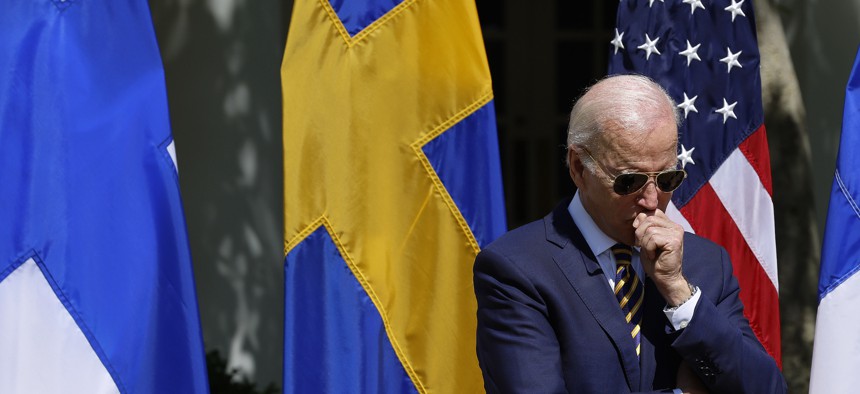
Chip Somodevilla/Getty Images
Biden’s Asia Trip is ‘Proof’ That US Can Focus On Two Fronts At Once, Officials Argue
His first presidential Pacific crossing aims to convince wary leaders that Washington is not losing focus on China.
White House officials love saying the Biden administration can walk and chew gum at the same time. President Joe Biden’s trip to Asia, which begins Friday, is a chance for him to prove it.
Biden’s trip to Tokyo and Seoul, which runs through Tuesday, will happen against the backdrop of Russia’s war in Ukraine. The White House is seeking to prove to allies and adversaries that the United States can rally the world against a Russian invasion while working to confront China’s long-term strategic challenge.
The balancing act began before the trip even started. On Thursday, Biden met with the Finnish and Swedish leaders at the White House to discuss their bids to join NATO an hour before boarding Air Force One for his first trip to Asia as president. The president was en route to Seoul when the Senate passed $40 billion in aid for Ukraine, sending it to his desk for signature.
“It will show in living color that the United States can at once lead the free world in responding to Russia’s war in Ukraine and at the same time chart a course for effective, principled American leadership and engagement in a region that will define much of the future of the 21st century,” National Security Advisor Jake Sullivan said Wednesday.
On the trip, Biden will meet with Korean President Yoon Suk-yeol, who was just sworn in last week, and later with Japanese Prime Minister Fumio Kushia, who took office in October, Sullivan said. He’ll also join a meeting of the Quad with leaders from Japan, India, and Australia.
“I think the mission from the White House perspective is mostly to get to know their counterparts and demonstrate that they’re paying attention to Asia despite what’s happening in Ukraine,” said Zack Cooper, a senior fellow at the American Enterprise Institute.
In March, the administration released the 2022 National Defense Strategy, which maintained China as the United States’ primary security challenge, while dealing with the regional crisis in Europe. In the weeks since, the U.S. has committed billions in aid in weapons and has expanded its military presence in Europe to more than 100,000 troops for a fight that military planners now expect could drag on for months or years.
On Thursday, a senior defense official said the president’s trip was “proof positive” the United States could maintain both fronts.
“Everybody's focused on Ukraine, and we understand that, but that doesn't mean that we've stopped working with allies and partners in the Indo-Pacific, doesn't mean we stopped our air and naval activity in the Indo-Pacific” in the 85-day old war, the official said.
While the U.S. has sent thousands of its Stinger anti-aircraft and Javelin anti-tank missiles to Ukraine—prompting the Pentagon to meet with defense industry leaders about rebuilding the stockpile—those pressures do not affect Indo-Pacific weapons sales, the official said.
Biden has galvanized the world in its response to the Russian invasion, including driving global sanctions against Moscow, facilitating arms transfers from allies, and ensuring that NATO is united in its support of Kyiv. That ability to rally has important implications for Asia, including Taiwan, where people worry they could suffer the same fate as Ukraine if China decides to invade.
America’s ability to assemble a global coalition and impose economic consequences on Russia provides a good “template” that the administration can build on when thinking about how to protect Taiwan from a potential Chinese invasion, Charles Edel, a senior advisor at the Center for Strategic and International Studies, told the House Foreign Affairs Committee on Thursday at a hearing on how the conflict in Ukraine is affecting the Indo-Pacific region.
Some experts predict Biden will be explicit with allies on the trip that he could rally the world around them as well, including if a conflict broke out in Asia at the same time as the war in Ukraine.
“There is nervousness, especially in Taiwan and in Japan to some extent, about whether the U.S. can handle two major contingencies,” Michael Green, the senior vice president for Asia at the Center for Strategic and International Studies, said on a press call previewing the trip. “Can we handle Ukraine and, if Taiwan were suddenly a crisis, handle that at the same time?...I think you’ll see some statements from the president that go right at that little bit of uncertainty about our ability to – not our intentions, really, but our ability to handle major challenges in Europe and Asia at the same time.”
It’s possible the conflict in Ukraine could draw attention away from the Indo-Pacific in the short term, if government bodies like the National Security Council spend time holding meetings on the war, for example. But, it could lead to a greater focus on the region if a crippled Russia demands less of America’s attention after the war, Cooper said.
“A weakened Russia and strengthened NATO may mean the U.S. can pay more attention to Asia,” he said. “In the long term, I think that could be helpful from an Asia standpoint.”